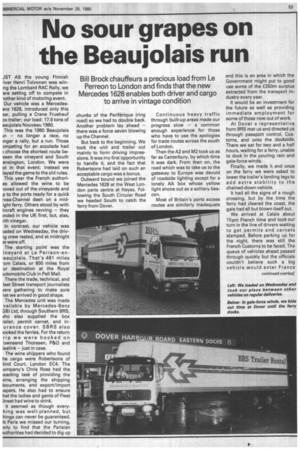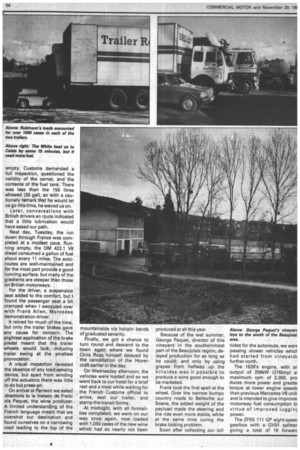No sour grapes on the Beaujolais run
Page 55

Page 56

Page 57

If you've noticed an error in this article please click here to report it so we can fix it.
Bill Brock chauffeurs a precious load from Le Perreon to London and finds that the new Mercedes 1628 enables both driver and cargo to arrive in vintage condition
JST AS the young Finnish -iver Henri Toivonen was winng the Lombard RAC Rally, we ere setting off to compete in other kind of motoring event. Our vehicle was a Mercedesenz 1628, introduced only this aar, pulling a Crane Fruehauf ox trailer; our load: 17.5 tons of eaujolais Nouveau 1980.
This was the 1980 Beaujolais in — no longer a race, no Inger a rally, but a run. Those )mpeting for an accolade had ) choose the shortest route beveen the vineyard and South ensington, London. We were ot in that event; instead we layed the game to the old rules. This year the French authories allowed the wine to be loved out of the vineyards and p to the ports ready fOr a quick ross-Channel dash on a midig ht ferry. Others stood by with ircraft engines revving — they inded in the UK first, but, alas, rith vinegar.
In contrast, our vehicle was )aded on Wednesday, the driv1g crew rested, and at midnight te were off.
The starting point was the ineyard at Le Perreon-eneaujolais. That's 481 miles -om Calais, or 600 miles from ur destination at the Royal utomobile Club in Pall Mall, There the trade, technical, and feet Street transport journalists vere gathering to make sure lat we arrived in good shape. The Mercedes unit was made vailable by Mercedes-Benz 3B) Ltd, through Southern BRS, vho also supplied the box railer, permit carnet, and inurance cover. SBRS also looked the ferries. For the return rip we were booked on 'ownsend Thoresen, P&O and ealink — just in case.
The wine shippers who found he cargo were Robertsons of iind Court, London EC4. The ,ompany's Chris Ross had the ixacting task of providing the vine, arranging the shipping locuments, and export/import )apers. He also had to ensure hat the ladies and gents of Fleet itreet had wine to drink.
It seemed as though everyhing was well-planned, but hings can never be guaranteed. kt Paris we missed our turning, )nly to find that the Parisian iuthorities had decided to dig up chunks of the Periferique (ring road) so we had to double back. Another problem lay ahead — there was a force seven blowing up the Channel.
But back to the beginning. We took the unit and trailer out mainly to form driving impressions, it was my first opportunity to handle it, and the fact that Robertsons had laid on such an acceptable cargo was a bonus.
Outward bound we joined the Mercedes 1628 at the West London parts centre at Hayes. Following the South Circular Road we headed South to catch the ferry from Dover. Continuous heavy traffic through built-up areas made our progress slow — a common enough experience for those who have to use the apologies for trade routes across the south of London.
Then the A2 and M2 took us as far as Canterbury, by which time it was dark. From then on, the road which was to take us to the gateway to Europe was devoid of roadside lighting except for a lonely. AA box whose yellow light shone out as a solitary beacon.
Most of Britain's ports access routes are similarly inadequate and this is an area in which the Government might put to good use some of the £250m surplus extracted from the transport industry every year.
It would be an investment for the future as well as providing immediate employment for some of those now out of work.
At Dover a representative from BRS met us and directed us through passport control, Cus toms, and onto the dockside. There we sat for two and a half hours, waiting for a ferry, unable to dock in the pouring rain and gale-force winds.
Finally, we made it, and once on the ferry we were asked to lower the trailer's landing legs to add extra stability to the chained-down vehicle.
It had all the signs of a rough crossing, but by the time the ferry had cleared the coast, the gale had all but blown itself out.
We arrived at Calais about 10pm French time and took our turn in the line of drivers waiting to get permits and carnets stamped. Before parking up for the night, there was still the French Customs to be faced. The queue of vehicles ahead passed through quickly but the officials couldn't believe such a big vehicle would enter France empty. Customs demanded a full inspection, questioned the validity of the carnet, and the contents of the fuel tank. There was less than the 150 litres allowed (33 gal), so with a cautionary remark that he would let us go this time, he waved us on.
Later, conversations with British drivers en route indicated that a little lubrication would have eased our path.
Next day, Tuesday, the run down through France was completed at a modest pace. Running empty, the OM 422.1 V8 diesel consumed a gallon of fuel about every 11 miles. The autoroutes are well-maintained and for the most part provide a good running surface, but many of the gradients are steeper than those on British motorways.
For the driver, a suspension seat added to the comfort, but I found the passenger seat a bit cramped when I swopped over with Frank Allen, Mercedes demonstration driver.
It rained for much of the time, but only the trailer brakes gave any cause for concern. The slightest application of the brake predal meant that the trailer wheels would lock, inducing trailer swing at the smallest provocation.
A visual inspection revealed the absence of any load-sensing device, but apart from winding off the actuators there was little to do but press on.
On arrival at Perreon we asked directions to la maison de Francois Paquet, the wine producer. A limited understanding of the French language meant that we overshot our destination and found ourselves on a narrowing road leading to the top of the mountainside via hairpin bends of graduated severity.
Finally, we got a chance to turn round and descend to the town again where we found Chris Ross himself delayed by the cancellation of the Hovercraft earlier in the day.
On Wednesday afternoon, the vehicles were loaded and so we went back to our hotel for a brief rest and a meal while waiting for the French Customs official to arrive, seal our trailer, and stamp the transit forms.
At midnight, with all formalities completed, we were on our way once again, now loaded with 1,050 cases of the new wine which had so nearly not been produced at all this year.
Because of the wet summer, George Paquet, director of this vineyard in the southernmost part of the Beaujolais region, delayed production for as long as he could; and only by using grapes from halfway up the hillsides was it possible to produce a wine good enough to be marketed.
Frank took the first spell at the wheel. Over the narrow bumpy country roads to Belleville sur Soane, the added weight of the payload made the steering and the ride even more stable, while at the same time curing the brake locking problem.
Soon after collecting our toll ticket for the autoroute, we were passing slower vehicles whict had started from vineyarde further north.
The 1628's engine, with ar output of 206kW (276bhp) ai maximum rpm of 2,300, pro duces more power and greatei torque at lower engine speeds than previous Mercedes V8 unit: and is intended to give improve( motorway fuel consumption ID) virtue of improved lugginc power.
The ZF5S 111 GP eight-speec gearbox with a GV91 splitter giving a total of 16 forwarc
]ears, produced just the right -.:hoice of ratio for all occasions enabling the power to be kept on 311 the time.
A clear night sky and a full noon made driving conditions deal. Using the combination of 'og and dipped mainbeam lights gave good forward vision with)ut dazzling oncoming traffic, he heater was set to keep the light's chill at bay without enouraging drowsiness, and the 'alio picked up the BBC's alllight station clearly.
On the long gradients before aris the speed hardly dropped Jelow 45mph. On the downhill gradients, the efficient exhaust Drake gave a steadying influence. Each well-planned service station and picturesque layby we passed was lined with lorries whose drivers had run out of driving hours.
At the appointed time we swopped drivers, changing over the tacho before moving off. A slight ground mist as we passed over some of the hills did not affect visibility from cab height, but caused the mirrors to mist over for short spells, restricting our view of fast-moving vehicles coming up from behind.
The rounded design of the new-generation cab was supplemented by a roof spoiler which reduced the drag created by the 4m (13ft) high box trailer. Over the return journey, fuel consumption averaged out at just over 7mpg so that the 400-litre (88 gal) tank was more than adequate to see us home without having to stop for refuelling.
Having left the A6 and the Periferique (where traffic seemed extraordinarily heavy for 4.30 in the morning) we made good time to the end of the Al with its long straights to Bethune, still some '69kM (43 miles) from Calais. Northern France, like Britain, has yet to connect many of its motorways to the Channel ports.
Having come to the end of my four-hour driving period we changed over again, only to encounter the morning rush hour at its peak made up of innumerable farm tractors, mopeds and sleepy car drivers as well as the Beaujolais traffic heading for the ferry. At 8.55am we arrived, with little time to spare.
The White lorry which had left Perreon with us had arrived a few minutes before us, refuelling on the way, our average speed had been 77km/h (48 mph), and we had seen only one police patrol in the 962-mile round trip on French soil.
British Customs have the reputation of being the most exacting in Europe.
We had submitted cargo documentation before departure, so that the travelling document had only to be checked against them, but it still took us two hours to clear. We left others not so fortunate backing into unloading bays.
At a more sedate pace we continued on to London passing no fewer than nine police patrols — no doubt checking tachograph installations.
The Mercedes 1628 fitted with the L-type sleeper cab proved comfortable to drive under very exacting conditions. Parabolic springs gave a soft ride while maintaining a low kingpin height with the total height remaining below 4m (13ft) with a standard box trailer. The steel cab is well equipped with driver suspension seat, roof hatch, padded sound and heat insulation, side vents to stop the side windows misting up, and dual bunks — which we didn't use on this run.
The engine's increased power and torque gives the vehicle increased lugging power over a wide band of engine revs for improved etonomy and „a geared speed of 115km (72mph). Gearbox gat&, positions follow the conventinal pattern, moving towards tlikdriver as they become higher,.,v),(ith the detent dividing the top and bottom ratios.
A document box placed between the seats proved practical and a lid kept all the paper work needed in transit secure.
There were other heavy commercials On the run — those that left on the midnight ferries were breaking bulk in London next morning. Our cargo was ready for drinking by lunchtime, and when you consider that it sold al less than £2 per bottle within hours, the conclusion must be that transport by road is still toc cheap. .




































































































